Little tricks in growing pepper seedlings
Pepper came to us from the coast of Mexico. Since this is a southern plant, lovers of summer cottages are wondering how to properly grow pepper seedlings. It can be sweet and bitter, but the main points are the same for all varieties.
Content:
- Seed and soil preparation
- Planting seeds and caring for seedlings
- Picking and hardening
- Landing in the ground
Seed and soil preparation
The preparation pepper seedlings begin to engage in February until mid-May. Pepper seeds lose their germination after three years of storage. Before planting, they must be sorted out and damaged and darkened removed.
In order to check whether the seed is suitable for planting, it must be placed in a 3% salt solution (for 1 liter 30 grams).
Seeds, which after 7 minutes float up can be thrown away. The seeds that have settled to the bottom are removed, washed with water, dried and started to prepare for sowing.
The seed, pre-etched in potassium permanganate and treated with a growth stimulator, is soaked in warm water. The seeds are laid out on a cloth and placed in a warm place, such as a radiator. It is important to keep the seeds in a humid environment. Pepper seeds germinate for 1.5 to 2 weeks. You can put the soaked seeds in a thermos with water at 40 degrees for 2 hours.
For correct cultivation of pepper seedlings use the following types of substrates:
- Ready-made soils. Soil mixtures prepared especially for peppers are the most reliable option for planting. They will avoid damage from infections and pests.
- Self-prepared soil. Experienced summer residents prepare a substrate based on soil, humus and peat. If you decide to prepare the soil yourself, do not take the land from the site where nightshades were grown in the previous year and spill it thoroughly with a solution of potassium permanganate.
- Coconut substrate. Good for growing peppers
- Peat tablets. A very convenient option for sowing seeds. When transplanting and picking, the plant, along with the tablet, is simply transferred into a large container.
- Soil with the addition of hydrogel. Adding hydrogel to the soil will keep moisture in the soil longer. To do this, the balls already swollen in water are added directly to the soil. If you add dry granules, then when they swell, they can displace the earth from the bowl.
The quality in the future and the harvest largely depend on the correct preparation for planting seedlings, therefore the process requires close attention.
Planting seeds and caring for seedlings
To properly grow pepper seedlings, you need to pay attention to all growth factors:
- The soil.
- Humidity.
- Illumination.
- Top dressing.
For growing pepper seedlings, special boxes, peat pots, and plastic cups are used.
Craftsmen suggest planting seeds even in mayonnaise bags. The most important thing ensure good drainage in the tank using sand and small pebbles, and do not forget to punch holes in the bottom. This will avoid stagnation of water during watering and root rotting.
The soil is spilled with a warm, weak solution of potassium permanganate. Pepper seeds prepared for sowing are laid out at a distance of 2 centimeters into small grooves, covered with soil by 1 centimeter and slightly compacted.To provide the seedlings with the most comfortable temperature (25-30 degrees) and humidity, the boxes with them are covered with a film or sheet of glass and placed in a warm place.
Under good conditions, the first shoots will appear within 10 days. When they appear, the boxes are rearranged to the light and the covering material is raised to avoid the accumulation of condensation. The glass is removed when the bulk of the seedlings levels out and the first pairs of leaves begin to appear. If after two weeks not a single seedling has appeared, then the seedling has failed.
It should be ensured that the soil is always well moistened.
Water the seedlings with water room temperature for at least a day. When watering, it is necessary to avoid waterlogging of the substrate. To maintain a comfortable humidity, the green mass is sprayed, or an air humidifier is used. Avoid drafts and use a covering material when ventilating.
With the appearance of seedlings, they begin to be illuminated, at first this is done around the clock with the help of fluorescent lamps. To provide sufficient light for the seedlings, it is necessary to keep the windows clean and make reflective screens with foil. As the green mass grows, it is supplemented with light in the morning and in the evening, so that in total the length of the day is 12-18 hours.
You can feed the plants every 10 days after the first leaves appear with ammonium nitrate.
Complex feeding nitrogen, potassium, phosphorus fertilizers must be carried out before planting in open ground. Pepper seedlings are quite capricious and, in order to grow strong seedlings, you need to make a lot of effort and follow all the rules.
Picking and hardening
Regarding the picking of young shoots among gardeners, there will be controversy. Opponents insist that after it the pepper slows down growth, spending energy on restoring the root system. Proponents, however, say that after a dive, the plants increase their vegetative mass better and get more nutrients.
Pepper seedlings dive when the first true leaves appear, about three weeks after the start of cultivation.
The seedling is carefully removed from the well-moistened soil, holding it by the upper leaves by one third, the main root is removed and transferred to separate containers with a volume of about 200 milliliters. Large dishes are useless, as the roots can rot or build up excess green mass. Try to make sure that the root does not bend up and is well spread. The stalk is buried almost to the first leaves, sprinkled with earth, compacted and watered.
Some recommend carrying out another pick when the young seedling fills the entire volume of the container with roots. The young shoot is transferred to a large bowl.
The picking is also convenient because the plants, planted in separate cups, are easy to move apart. Pepper does not like to touch the neighbor with the foliage and begins to stretch upward, spending growth energy.
Tempering allows you to get powerful seedlings that are resistant to external environmental factors.
About a month before planting, the planting material begins to be exposed to open sunlight, gradually increasing the exposure time.
To do this, the boxes are taken out onto the balcony or a window is opened. In this case, it is necessary to ensure that the seedlings do not fall under drafts that have a negative effect on them and do not experience a lack of moisture. The described actions are not necessary, but their use allows you to grow good seedlings and get a bountiful harvest.
Landing in the ground
Seedlings are ready for transplanting in at least 60 days. Seedlings of 70-80 days of age give a high yield. Disembarkation decision taken by visual inspection.
Plants should be intact, have 10-12 leaves, be 20-30 centimeters in height.
In mid-May, peppers are planted in a greenhouse or greenhouse, and in early June in open ground. One of the problems that a gardener may face is overgrowth.To avoid it, when picking seedlings, you should cut off the roots and not abuse fertilizing, especially nitrogen. If the plants do outgrow, reduce watering and lower the ambient temperature.
The pepper patch should:
- Be well lit.
- Have loose soil.
- Be protected from draft and wind.
- Have a pH of no more than 6.
Before transplanting, the seedling boxes are well spilled in order to gently remove the plants. Seedlings are transferred from pots together with an earthen clod. Pepper is sensitive to damage to the root system. The seedlings are carefully transferred into the holes, covered with earth and mulch, then the beds are abundantly watered.
The distance between the rows is 50-79 centimeters, in the row between the peppers 40 cm. If the distance between the plants is less, they will feel uncomfortable and stretch. The embedment depth is approximately the same as it was before transplanting.
Sweet and bitter peppers are planted in different places to prevent cross-pollination.
With the likelihood of night frosts, the transplanted peppers must be covered. Covering materials are also used to protect against bright sunlight for the first time after transplantation.
The main troubles in growing peppers await summer residents at the stage of growing seedlings. After transferring to open ground, the main care is reduced only to timely watering, protection from pests and subsequent harvesting.
Growing pepper quite painstaking work. But if all the requirements and recommendations are followed, the beds will delight you with an abundance of fleshy, multi-colored and healthy harvest of peppers.
You can learn a lot of tips on how to plant pepper seedlings by watching the video.



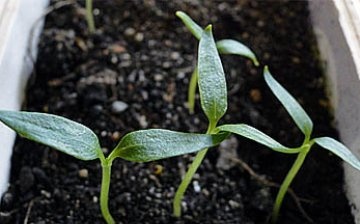
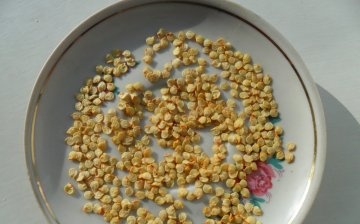
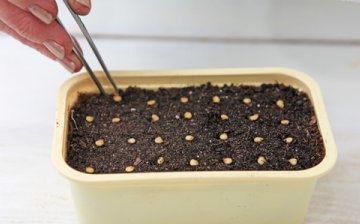
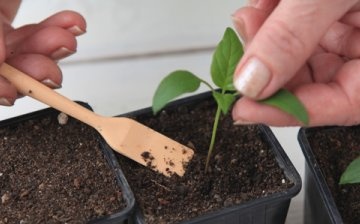
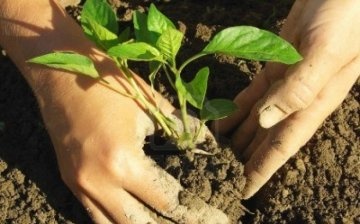





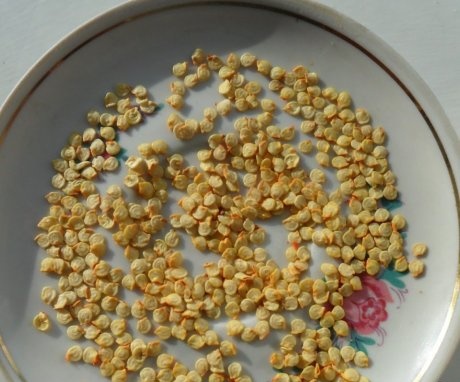
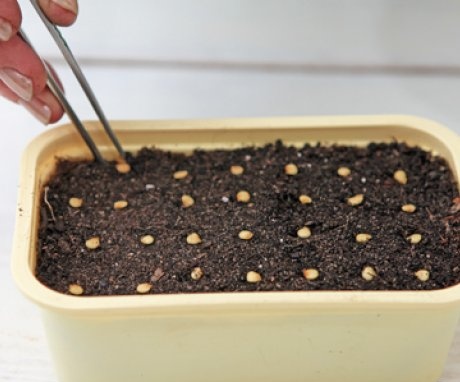
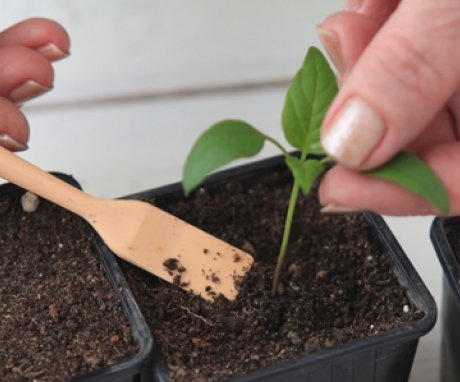
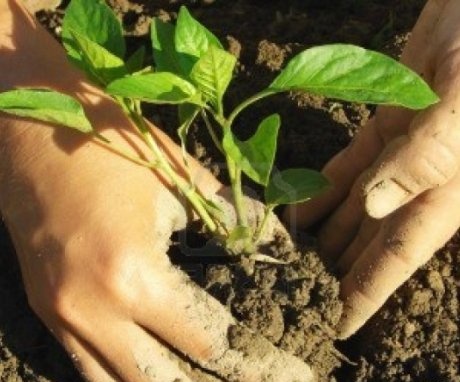
The main thing is not to fill the seedlings, to correctly pick and observe the temperature regime. If the soil is overfilled or overfed with fertilizers, the stem of the seedling may turn purple or turn black.
I have no particular difficulties growing seedlings of peppers. I buy soil for planting in the store, the seeds are mostly my own, I don't do top dressing in pots and everything grows well.